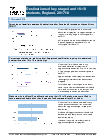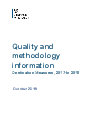Destinations of KS4 and 16 to 18 (KS5) students: 2018

Data on key stage 4 (KS4) and 16 to 18 (KS5) students going into apprenticeship, education and employment destinations.
Documents
Progression to higher education or training, England, 2015/16 cohort
Destinations of key stage 4 and 16 to 18 students 2018: main text
PDF, 430KB, 26 pages
Destinations of KS4 and 16 to 18 students 2018: progression to higher education or training
PDF, 837KB, 16 pages
Destinations of KS4 and 16 to 18 students 2018: key stage 4 national tables
ODS, 94.9KB
This file is in an OpenDocument format
Destinations of KS4 and 16 to 18 students 2018: 16 to 18 national tables
ODS, 201KB
This file is in an OpenDocument format
Destinations of KS4 and 16 to 18 students 2018: key stage 4 local authority and parliamentary constituency tables
ODS, 402KB
This file is in an OpenDocument format
Destinations of KS4 and 16 to 18 students 2018: 16 to 18 local authority and parliamentary constituency tables
ODS, 1.44MB
This file is in an OpenDocument format
Destinations of KS4 and 16 to 18 students 2018: key stage 4 institution level tables (revised)
ODS, 2.43MB
This file is in an OpenDocument format
Destinations of KS4 and 16 to 18 students 2018: 16 to 18 institution level tables (revised)
ODS, 3.63MB
This file is in an OpenDocument format
Destinations of KS4 and 16 to 18 students 2018: progression to higher education and learning tables
ODS, 1.73MB
This file is in an OpenDocument format

Destinations of KS4 and 16 to 18 students 2018: quality and methodology information
PDF, 769KB, 50 pages
Longer term destination measures for 2012 to 2013 cohort
ODS, 8.61MB
This file is in an OpenDocument format
This file may not be suitable for users of assistive technology. Request an accessible format.
If you use assistive technology (such as a screen reader) and need aversion of this document in a more accessible format, please email [email protected] .Please tell us what format you need. It will help us if you say what assistive technology you use.
Destinations of KS4 and 16 to 18 students 2018: additional and underlying data
ZIP, 22.2MB
This file may not be suitable for users of assistive technology. Request an accessible format.
If you use assistive technology (such as a screen reader) and need aversion of this document in a more accessible format, please email [email protected] .Please tell us what format you need. It will help us if you say what assistive technology you use.
Destinations of KS4 and 16 to 18 students 2018: pre-release access list
HTML
Details
This release provides information on the destinations of students reaching the end of key stage 4, 16 to 18 study, and also a new progression to higher education and training to measure:
- pupils who finished key stage 4 in 2016 to 2017 (destinations in the year following institution attendance)
- students who reached the end of 16 to 18 study in 2016 to 2017 (destinations in the year following institution attendance) – this cohort now includes additional students who took qualifications below level 3
- students who reached the end of 16 to 18 study in 2015 to 2016 (progression to higher education or training over 2 years after A levels or other level 3 qualifications, including a value-added score)
- pupils who finished key stage 4 in 2012 to 2013 and their activity 1, 3 and 5 years following institution attendance
The releases give breakdowns for specific student characteristics and institution types.
Destination measures statistics team
Email[email protected]
Published 17 October 2019
Last updated 6 February 2020 + show all updates
-
Published revised ‘Destinations of KS4 and 16 to 18 students 2018: key stage 4 institution level tables’ and updated ‘Destinations of KS4 and 16 to 18 students 2018: additional and underlying data’.
-
Added revised 16 to 18 institutional level tables and key stage 4 longer term destinations tables and commentary. Added revised progression to higher education and learning tables following an improvement in the processing.
-
First published.











Responses